My diary
Day 57 - 24 Jun 14
We leave the airport hotel and catch a taxi to the bus station. The bus is new with wide reclining seats. We sink into the padding and fall asleep for the first few hours. We stop for lunch at a restaurant sitting on the sea's edge - it's a picturesque setting - and eat Cap Cay. We are awake now and look out of the window appreciating the views. The road runs along the coast - a couple of fishermen stand in the shallows at the shore's edge. The countryside is lush, green and tropical. The houses stand on stilts, with triangular shaped slanting roofs. Decorative pieces of metal are crossed diagonally at the top of the roof. Balconies, like verandas, sit at the front of houses, with patterns carved into the banisters.
We enter Rantepao late. It's a busy town and it's dark outside now. The torrential rain has created unavoidable ankle deep puddles in the road. A man, hopeful of a tour the following day, drives us to our hotel (Duta
Tana Toraja - Funerals and Burial Sites
Sulawesi, Indonesia
Day 57 - 24 Jun 14
We leave the airport hotel and catch a taxi to the bus station. The bus is new with wide reclining seats. We sink into the padding and fall asleep for the first few hours. We stop for lunch at a restaurant sitting on the sea's edge - it's a picturesque setting - and eat Cap Cay. We are awake now and look out of the window appreciating the views. The road runs along the coast - a couple of fishermen stand in the shallows at the shore's edge. The countryside is lush, green and tropical. The houses stand on stilts, with triangular shaped slanting roofs. Decorative pieces of metal are crossed diagonally at the top of the roof. Balconies, like verandas, sit at the front of houses, with patterns carved into the banisters.
We enter Rantepao late. It's a busy town and it's dark outside now. The torrential rain has created unavoidable ankle deep puddles in the road. A man, hopeful of a tour the following day, drives us to our hotel (Duta
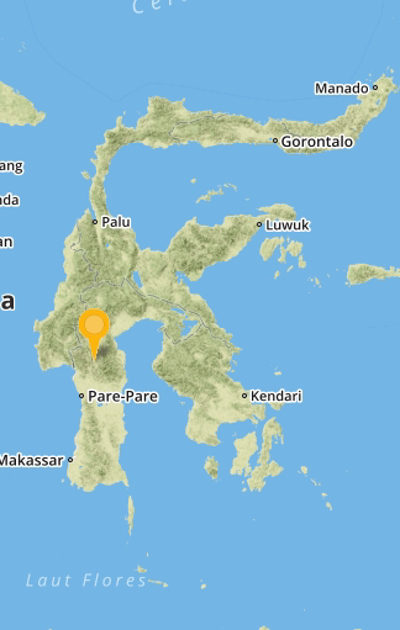
88 Cottages). The buildings are in the traditional style found in Tana Toraja and the garden is beautiful, filled with large leaved plants. After half an hour spent bargaining, we agree on a price with John, our new tour guide, for the next day. As luck would have it, the following day is a public holiday, so a multitude of funeral ceremonies are taking place.
Day 58 - 25 Jun 14
We drive through the mystical landscape of Tana Toraja. The road carves through rice paddies, shining luminous green in the sunshine. The surrounding hills rise dramatically from the ground, steep limestone karst cliffs, redolent of the islands in Ha Long bay. The buildings traditional to this area are called Rumar Tongkonan. The houses sit on stilts with roofs shaped like boats, the bow rising
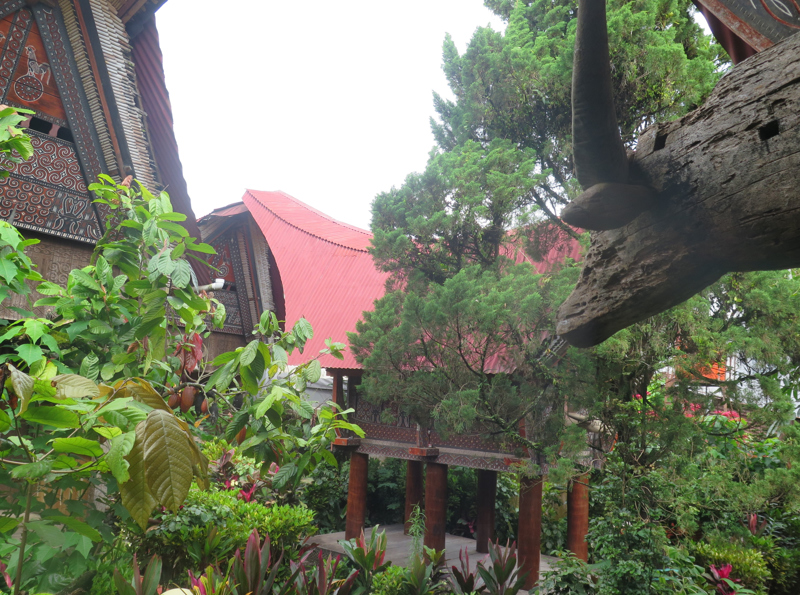
upwards at the front of the house, the stern to the back. They are wooden, with carved patterns painted in terracotta, orange, black and white. Squares filled with ordered swirls and geometric borders cover the sides. Depicted on the front two triangular panels are two cockerels facing each other standing on a decorative circle. They represent law and justice, the guardians of the house. These houses and rice barns, generally built in two rows facing each other, enhance the magic of the landscape with their unusual shape.
We visit Londa. A small paddy field sits in the base of a bowl, entered from one side. Opposite towers a wall of limestone - a pattern caused by running water, creates an effect of melting black paint dripping downwards against the white background. Old, thick vines hang looped against the rock. This is a house of the dead. Boat-shaped, crumbling wooden coffins are suspended above our heads. A hole is
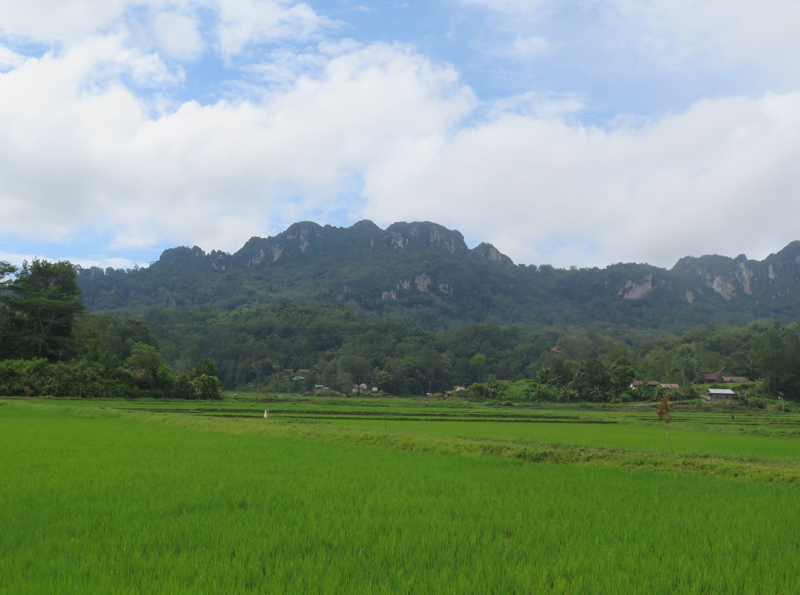
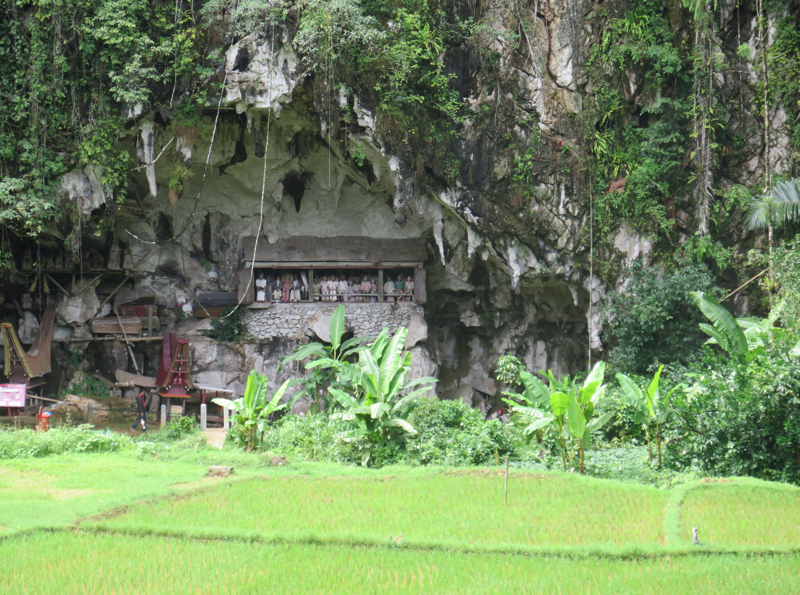
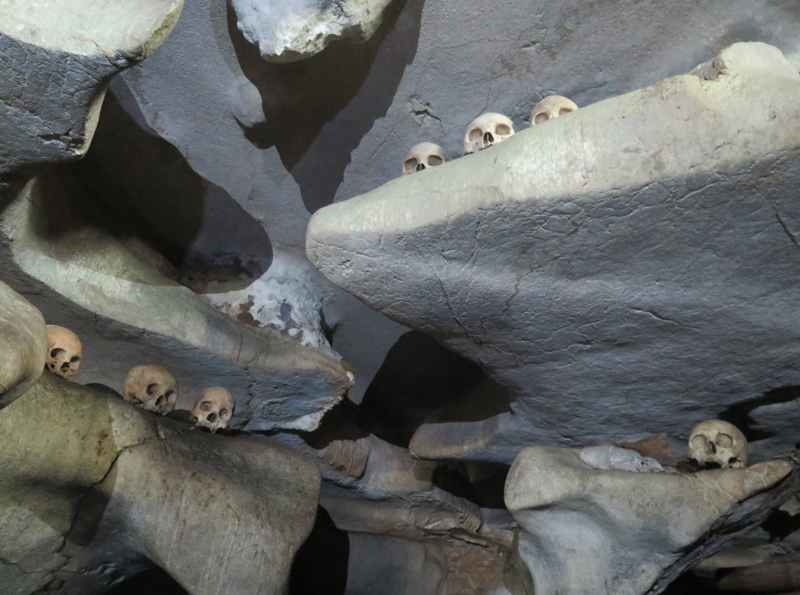
cut into the cliff like a box in the theatre. The audience of life-sized puppets modelled on the dead watch us from their balcony, we, the actors on their never changing stage.
We enter the cave beneath. The rock, bright green in places, is also smooth to touch. Curved holes and organic shapes eat into the stone. Coffins fill the cave, some covered in draped, decorative cloth or dirty lace. In one, a black skeletal head is visible beneath the disintegrating rotten wood and abundance of cigarettes, which have been placed as offerings to their spirit. A love story lives on in the form of 2 skulls placed next to each other on the floor in the shadows, a man and woman who had been banned from matrimony in life, but are joined now in death - the Torajan Romeo and Juliet.
In another cave, skulls are balanced on natural shelves. We continue down the tunnel at the back of the cave. The ground is slippery and
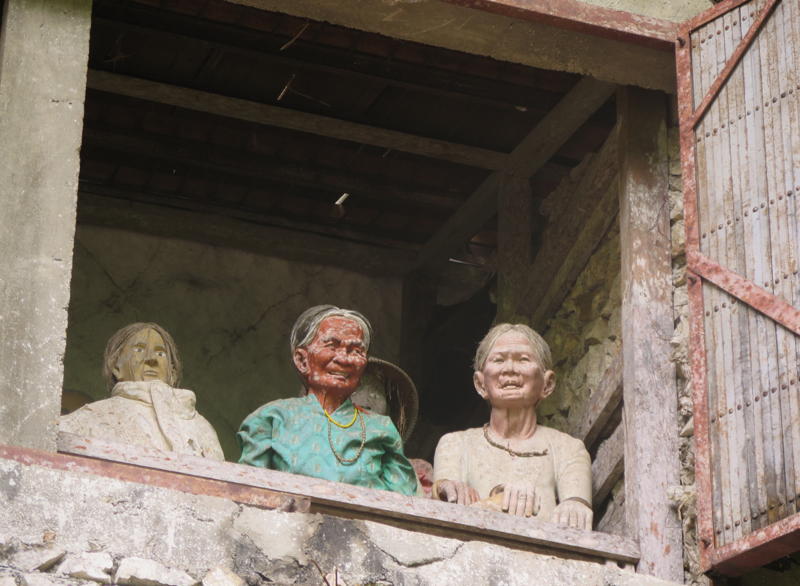

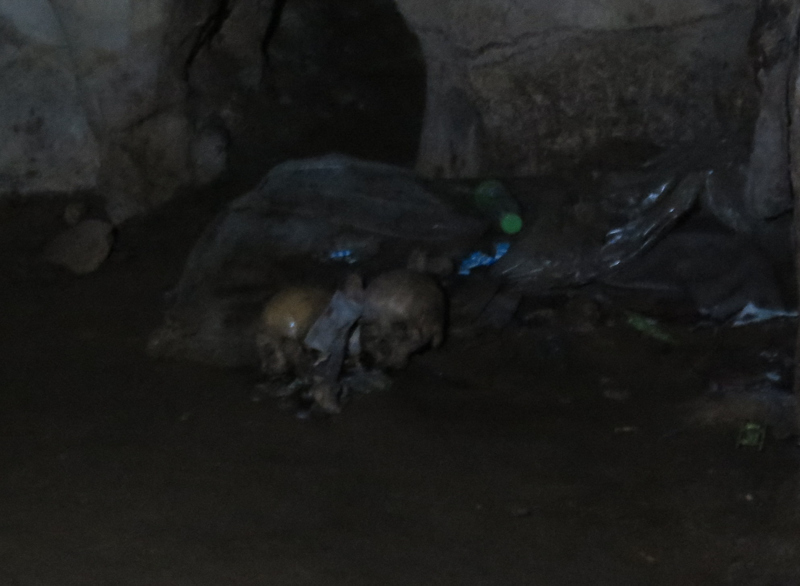

the corridor thin. We enter a room with a high ceiling, bats' wings beating overhead - they frantically fly in random directions, crashing into each other to escape our torch light. The passage continues for another 2 km, but our guide tells us it is too dangerous to continue with so little light. It is easy to lose one's self in the maze of tunnels. Black snakes, their poisonous bites fatal, inhabit small recesses. We retreat quickly.
The funeral ceremonies last 3 days. The funeral we are attending is in its 2nd day. As we approach, squealing, squawking and groaning perforates our ears, these discordant sounds elongated, simulating a monster in a horror movie. A man's droning voice can be heard over a loud speaker. We enter under an arch with a poster featuring the face of the deceased. It is a large funeral - he was clearly an important and wealthy man. As we walk down the muddy slope, live fat pigs, tied to bamboo (used to carry the weight of the pig on 2 men's shoulders) are lain the length of the path. Sometimes docile, laying quietly and at other times emitting the tormented noises we had heard from a distance, as if aware of their imminent fate.
Many people are in attendance, dressed in the traditional funeral attire - mainly black with maroon borders. Some of the men wear wraparound long skirts. Wooden traditional buildings, guests seated on the floor in the lower levels which are not boxed in by walls, surround the central area. In the middle of the buildings lays the bloody carcass of a buffalo, its head removed from its body. It is a gruesome and gory sight, the blue sky and sunshine above incongruous to this scene. Live pigs lay imprisoned on the ground near the corpses.
We watch as a procession of relatives walk in pairs past the bloody mess, dressed in matching outfits. An old man with a walking stick entwined by a serpent, leads the way. His long hair and beard is white, he is wearing red embroidered clothing, with a black and gold flat hat, a white looping scarf thrown across his stooping figure and his feet bare. The women in the procession are heavily made up, wearing black skirts and red, matching patterned tops. They carry plates covered in cloth. They are followed by teenage boys wearing pristine green shirts, carrying metal kettles. Men in black later surround the sacrificed animals, holding hands in a circle, enacting out a simple, slow side-stepping dance. Their song is two tonal, each note crescendos and diminuendos, as the singing gradually rises from a piano to a forte, the sound emanating from their mouths as an aay or oor.
Behind the buildings, previously sacrificed pigs are being cooked with the use of a giant blow torch - its powerful blue flame, turning orange
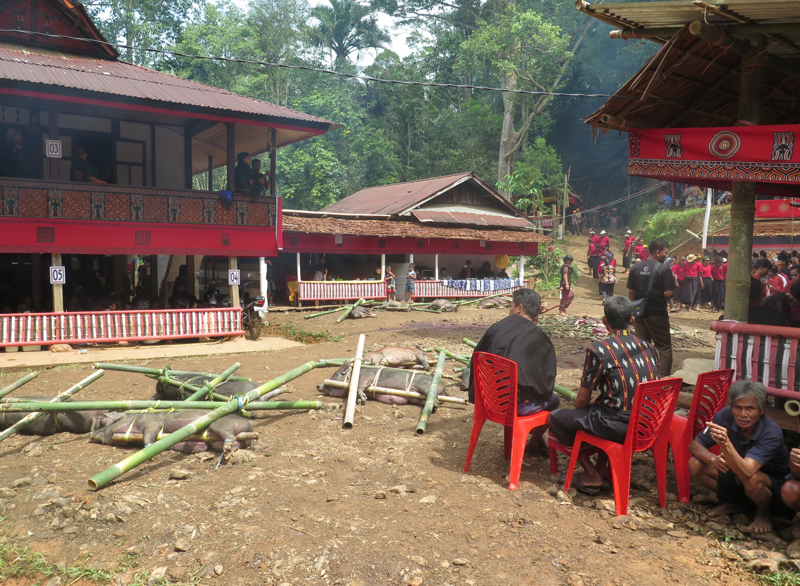

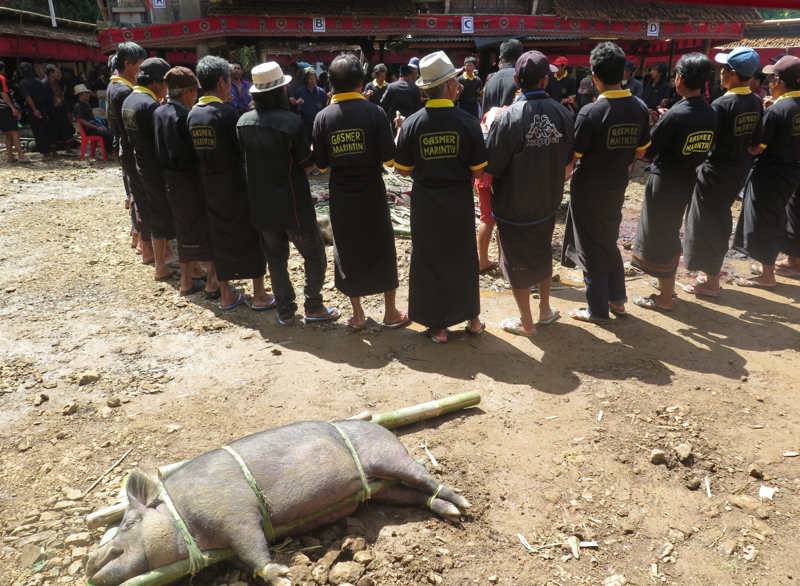
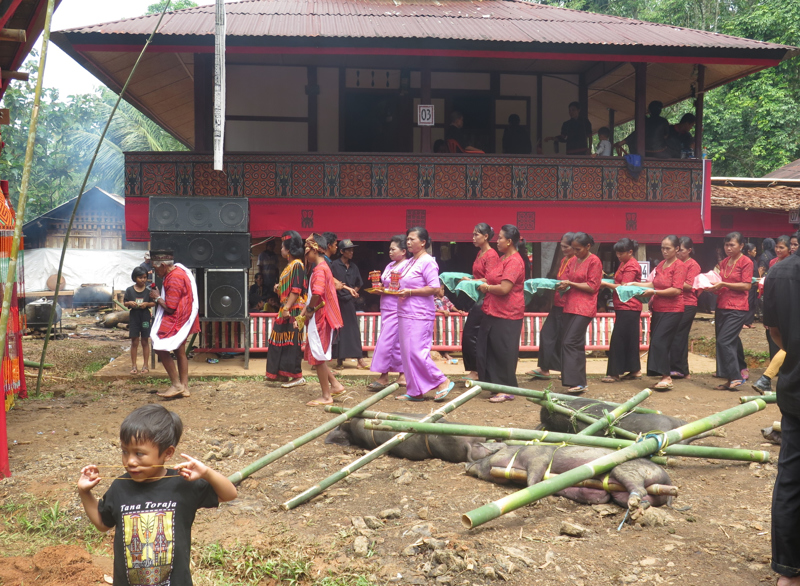
as it comes into contact with the pig. The pig's skin crackles metallic copper and tarnished silver beneath the blast. Blood intermingles with the squelching mud under foot. Next door, in juxtaposition to this, is a clean hut, its walls decorated with a beautiful patchwork, women eating cake and sitting around gossiping. Kids play on the grass, giggling and blowing bubbles, unfazed by their surroundings.
We sit for a short while in the hut with the family of the departed. They offer us tea and cakes. The grandson has returned from Jakarta for the ceremony and he speaks a little English, welcoming us. He is excited and energetic. This is clearly a celebration of a life past,not a mourning, and it is this aspect that I like. They invite us for lunch, but we decline this kind offer, mainly because Hannah's stomach is not yet fully recovered, although both the guide and I are relieved. It looks neither hygienic nor appetising. As we leave, the remaining pigs of the day are being sacrificed, their intestines and stomachs
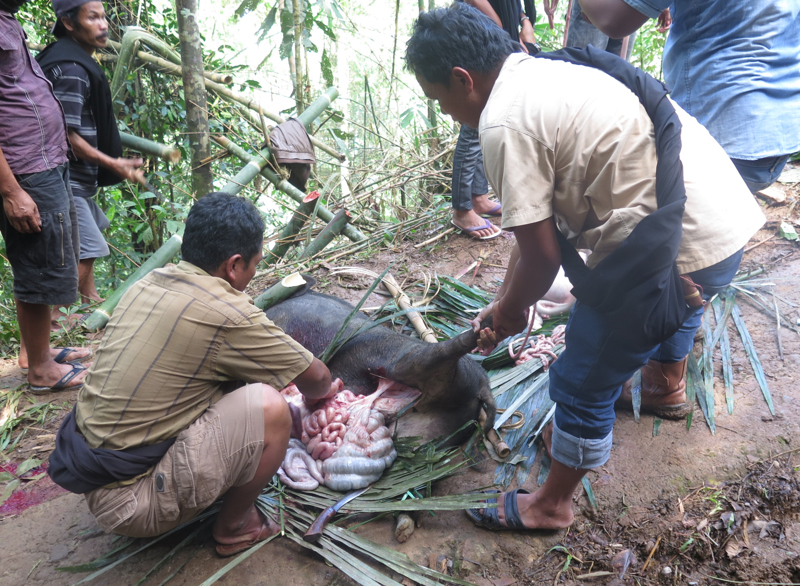
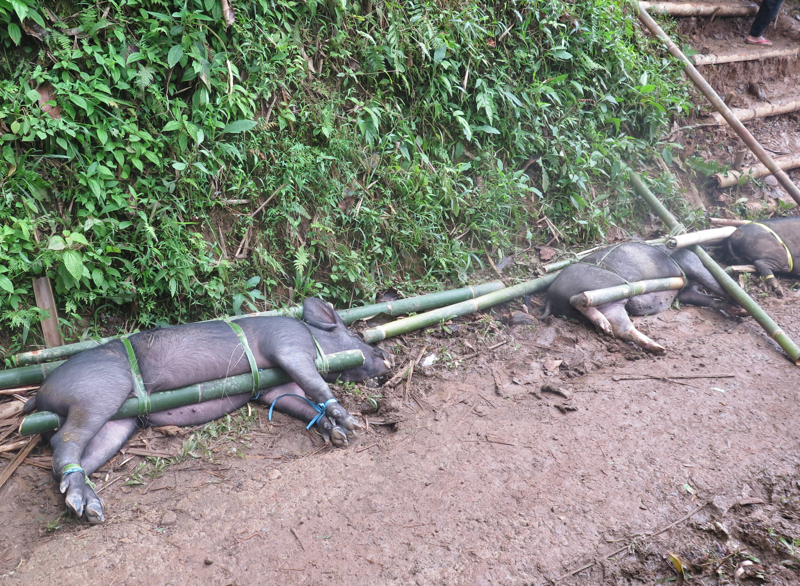

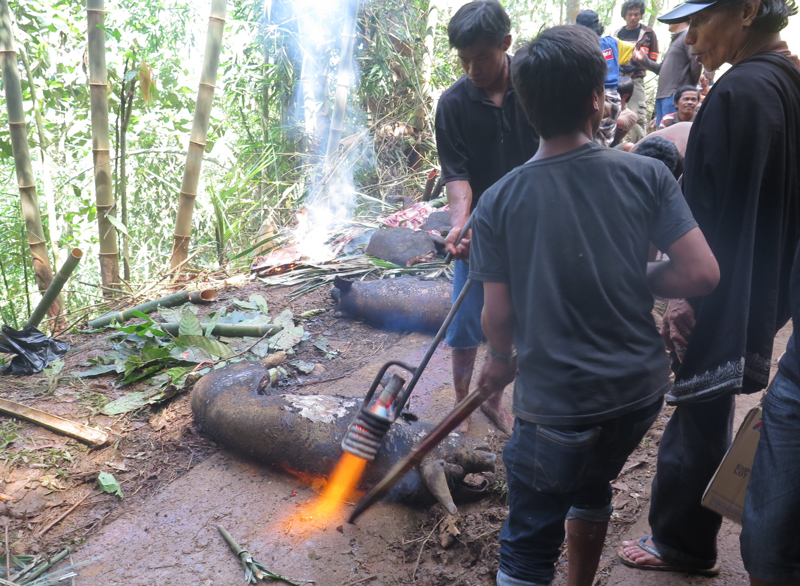
removed from the inside out. The blood gushing from the carcass is transferred to a bamboo container using cupped hands. Today, we understand a total of 30 pigs have been sacrificed, tomorrow the remaining 10 buffalos will meet the same fate.
We join the German girls for lunch, who have stopped at the same restaurant as us. It overlooks a paddy field, from where we watch a man first wash his white buffalo and then his motorbike - his two prized possessions. On the menu is both buffalo and pig, which is fitting, or ironic, after the events of the morning. I choose buffalo steak, since I haven't tried the meat before. It is a little tougher than beef with a gamier flavour.
After lunch we visit the baby graves. In the centre of a forest of bamboo, a large tree sits with holes cut into its sides, inside which the baby's dead bodies are placed, nailed up with small blackened doors. The dripping white sap from the tree acts as an alternative to breast milk to nourish the babies' spirits. This is their entrance to paradise. The tradition is no longer practiced since Christianity permeated the area and bodies are buried instead. The old tree is struggling to survive, unassisted by the small rectangular rooms hacked into its sides.
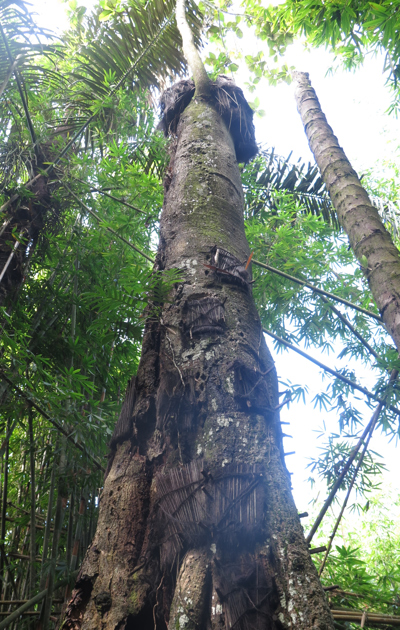
Suaya is a site similar to Londa - a white cliff face with a smattering of wooden coffins sitting on shelves attached to the rock. Construction work is taking place and no one stops me from clambering up the bamboo scaffolding in order to take a closer look at the Tau-Tau, standing on the platform halfway up the cliff. Their arms are leaning over the stone railing, with their hands held out in a plea or perhaps welcoming gesture. Mostly, they are carved from wood, the sculptor's skill amateur and their clothing's now in tatters. A couple, perhaps more recently made, have detailed faces, similar to the older waxwork models at Madame Tussaud's. We assume they more precisely imitate the appearance of the dead men they portray. We walk up the steep path at the side of the cliff to appreciate the view,
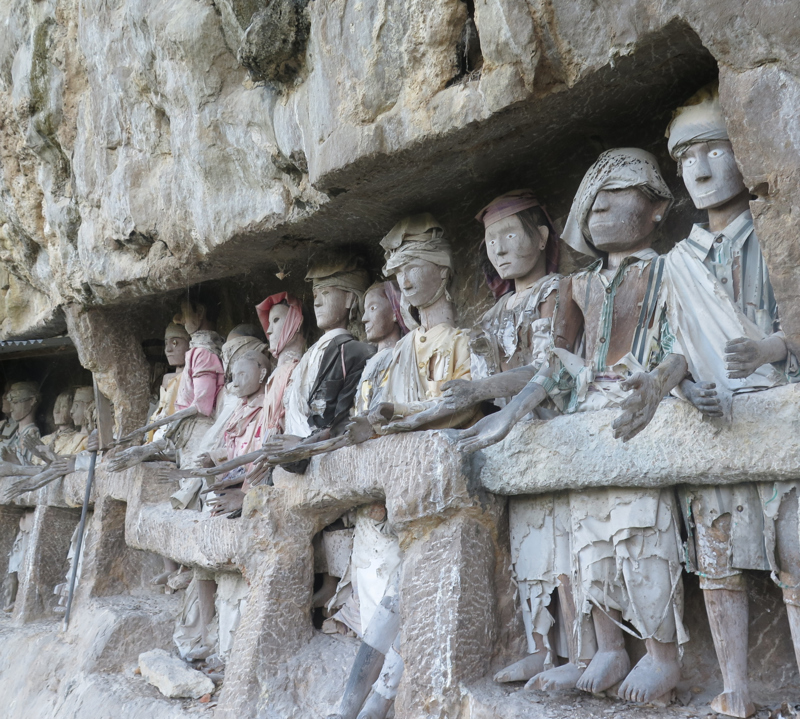
but it is now blocked by the trees.
Kiti Kesu is the final site we visit that day: another grave site with caves and cliffs. Some of the coffins have fallen to the ground and numerous human bones spew out of their filled bodies. An important government figure, his and his wife's statue sitting at the top of a building, has his own grave. A student from Makassar studying tourism asks if he can interview and film us for his project. Hannah explains that this site is so interesting due to the cultural differences, providing the example that in England coffins are buried beneath the ground, not hung upon cliffs. Our guide also kindly answers questions in Indonesian. We are shown inside a traditional house, which is now disused. Overlooking the paddy fields sit megalithic stones and a platform where the body would be placed at the funerary ceremony. The sun is setting and the forked path through

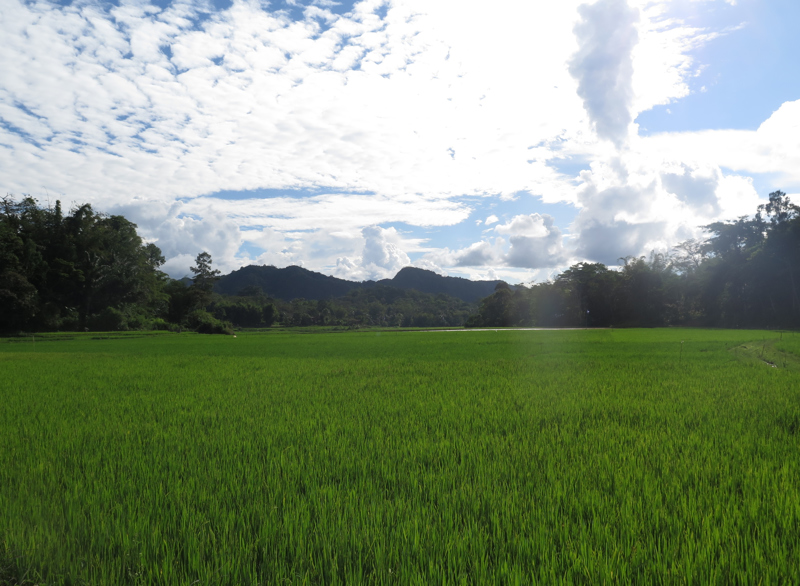
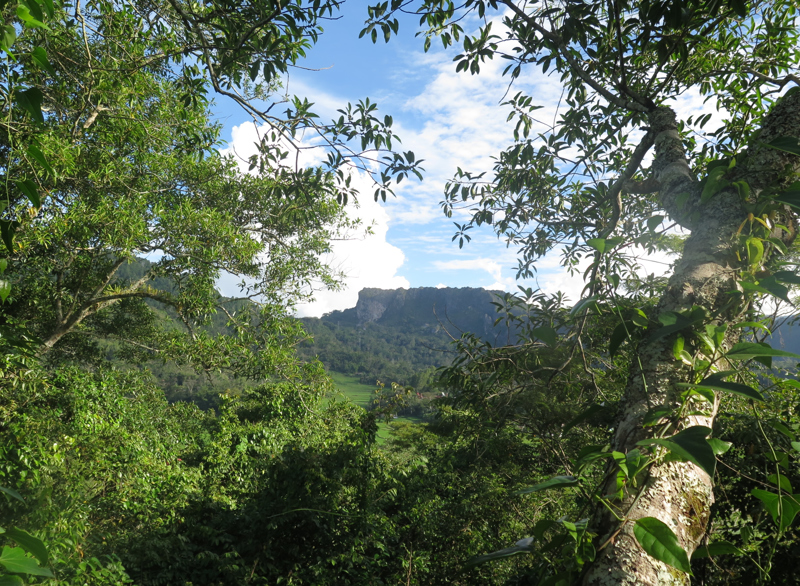

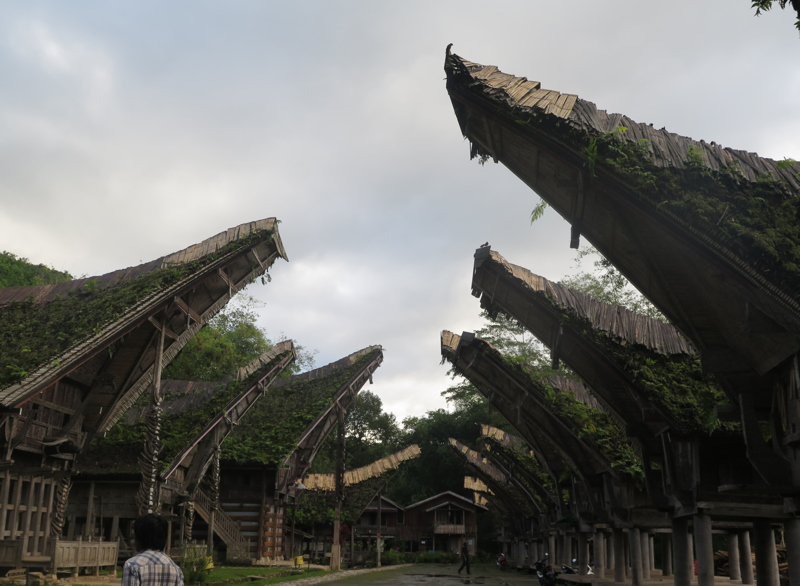

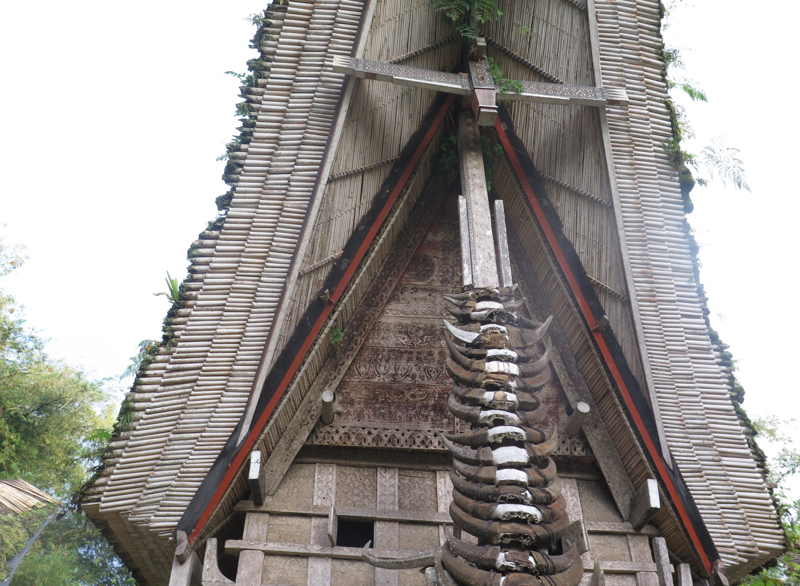

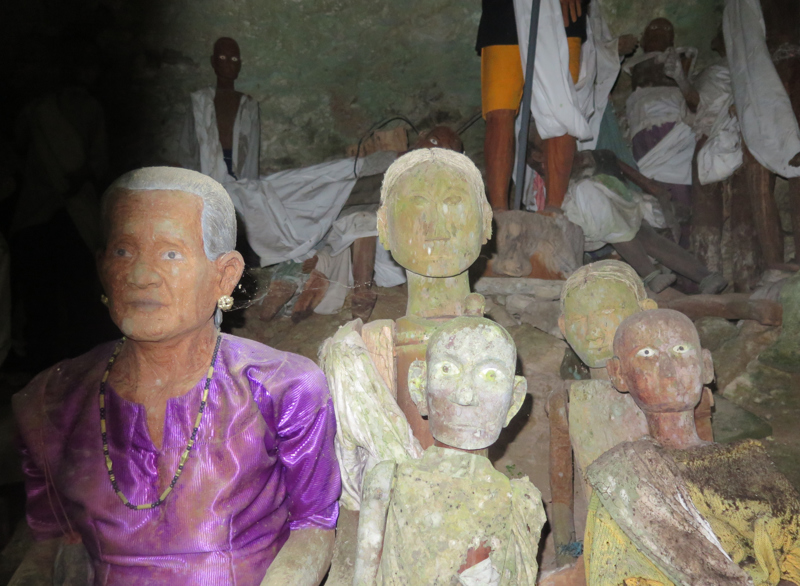


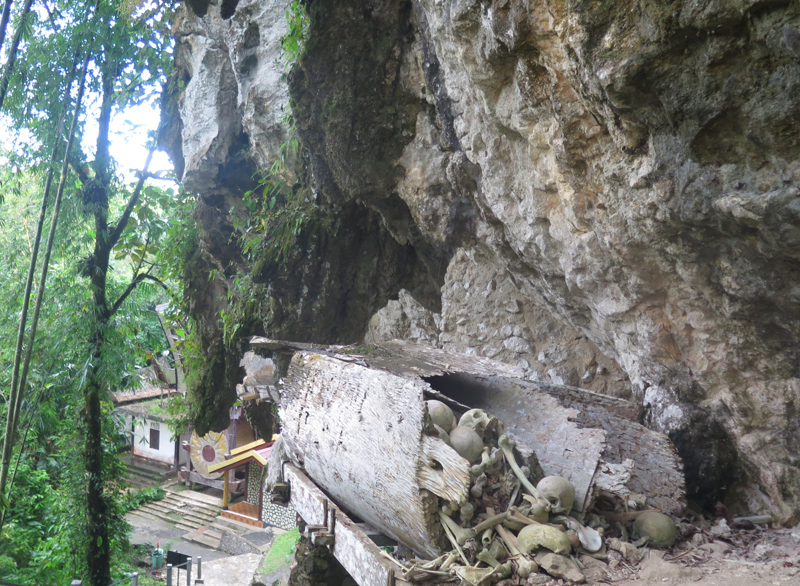

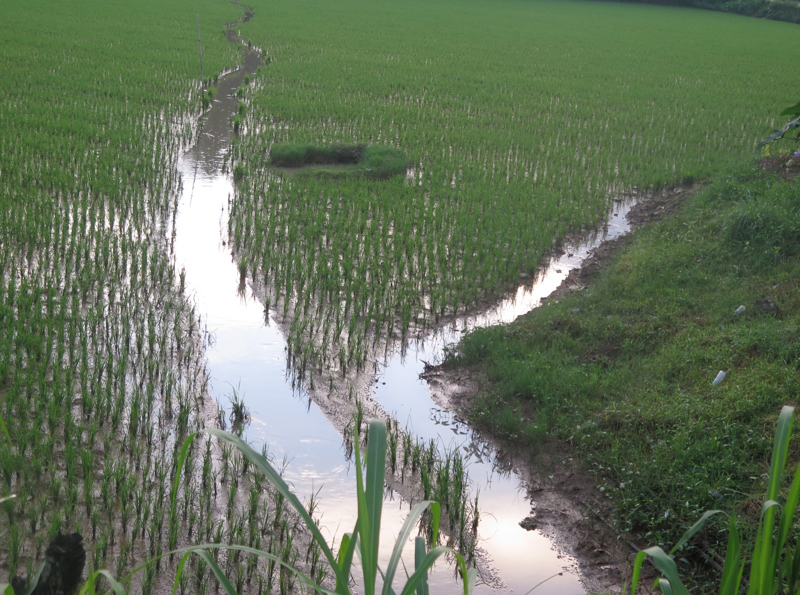
the paddy fields shines silver like a snake's split tongue.
Day 59 - 26 Jun 14
John our guide from yesterday arrives in the morning hoping we will book another day of touring. We want to relax on our balcony in the garden for the morning, but we agree to meet him at midday for a walk in the surrounding countryside. We catch a public Bemo and start out through the paddy fields, passing the workers. Rice is drying in the sun on the small paths built above the water level, so at times we have to walk on the rice as we can't jump over it. The rice paddies are dotted with scarecrow equivalents, mainly a simple wooden cross made from sticks, dressed in a t-shirt with a plastic bag acting as a head, but we see a creative version of a cross wearing a yellow hooded anorak with a portrait photo stuck where his face would be.
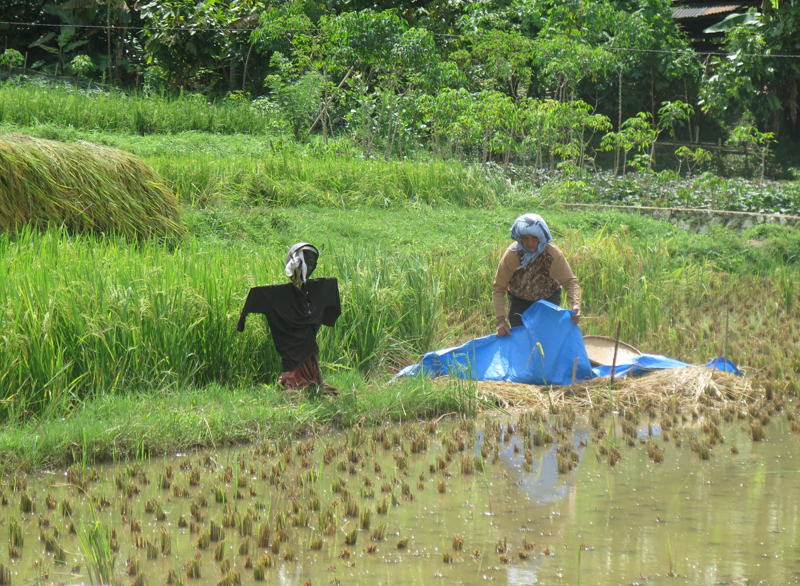

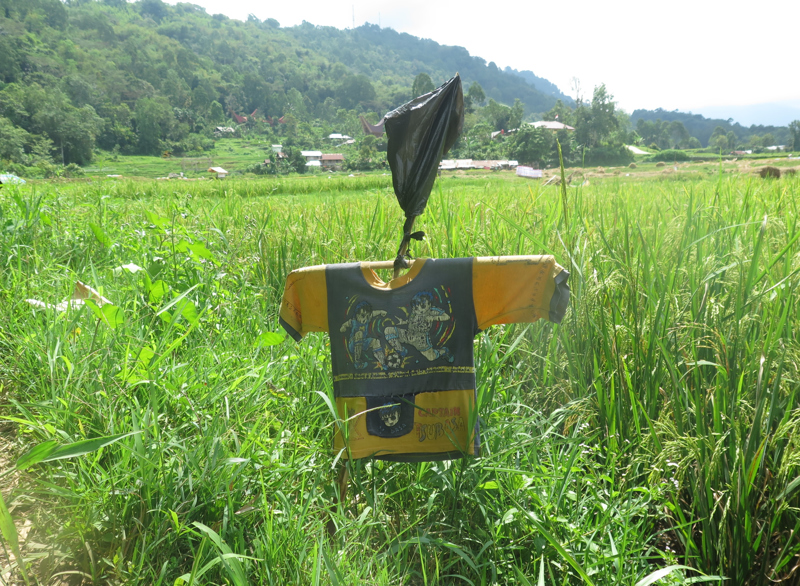
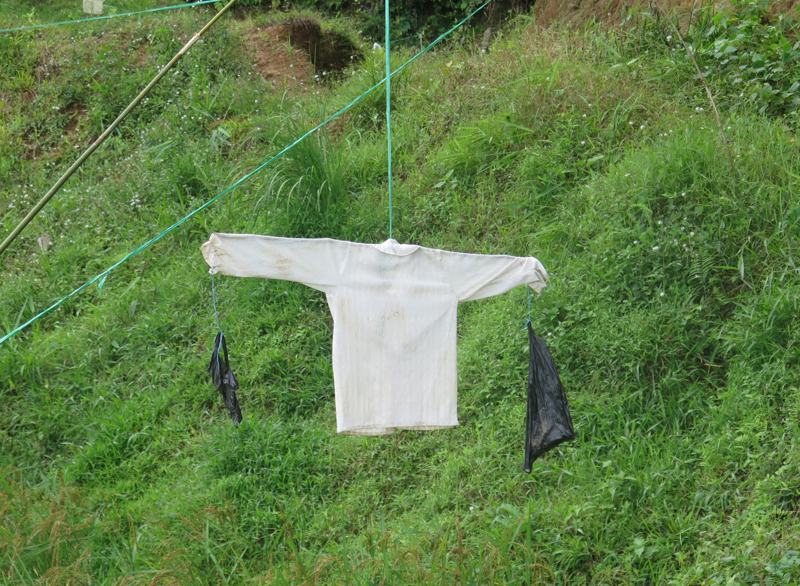
The path is slippery so most of our time is spent with our eyes fixed on the ground rather than the surrounding views. We jump across numerous streams. The guide rebukes Hannah for jumping next to a house where a dog sits in the doorway (unbeknownst to her) as it could be easily riled into attack.
John tells me that one of his relatives died a couple of years ago from rabies after being bitten by a dog, and I'm starting to wonder whether he is as scared of dogs as we are. A dog stands in the distance barking viciously guarding the way through on the path ahead, so John suggests we take a different route. This path heads up the hill into the jungle, but passing a house, 2 more dogs appear in our pathway. He brandishes a wooden stick and we keep close behind him, but the dogs seem little from frightened and follow closely on our heels barking madly. I am afraid they're going to attack and cannot help but speed up my walk. John notices and warns me not to run. I must

reek of fear.
Once past their territory, we are no longer a threat and they slowly back away. Relieved, my pathetic panic dissipates and I am able to enjoy our walk beneath the jungle canopy. Large brown dry leaves, which look like sheets of cardboard, crackle underfoot. A buffalo appears around a corner, blocking the pathway. His tether is too long to pass by without risking attack, so we scramble down the hill through the undergrowth to avoid this obstacle. Two more buffalos appear in our path. This time their rope should be short enough for us to pass safely. But the second buffalo charges. It is a close shave, but we escape unscathed.
By now my nerves are in tatters and I hopefully suggest that we should call it a day and head back to town. I had been totally unaware of the risks involved in a pleasant walk through the countryside and laugh that Han and I had considered going for a leisurely jaunt and exploration without a guide. Back on the road, the clouds begin to pour, so we take shelter on plastic chairs in the porch of a new, as yet uninhabited house. We share photos and discuss our families waiting for the rain to subside.
When at last the rain stops, we walk back into town. A motorbike passes us carrying 2 bloody buffalo heads on a stick, balanced one on each side on the back - remnants of a funeral from earlier in the day. We eat a late lunch in a restaurant and are serenaded by our driver from yesterday who plays the guitar and sings Torajan songs. Locals stop and join in, singing in harmony standing around the table. It's a nice end to our trip.
Day 60 - 27th June 14
A day of travel: we arrive off the night bus early. We spend the day sitting waiting for planes and sitting on planes and eventually arrive at our hostel in Kuala Lumpur at 1 am the following day. We have managed to spend the exact amount of Indonesian Rupees at the airport in Jakarta, so we are left with nothing to exchange. It is the end of our 2 month visa and time in Indonesia, a country of such diverse settings and cultures with still so much left to explore. All that was lacking was the food, so we are excited to arrive in a city with such a variety of cuisines available.
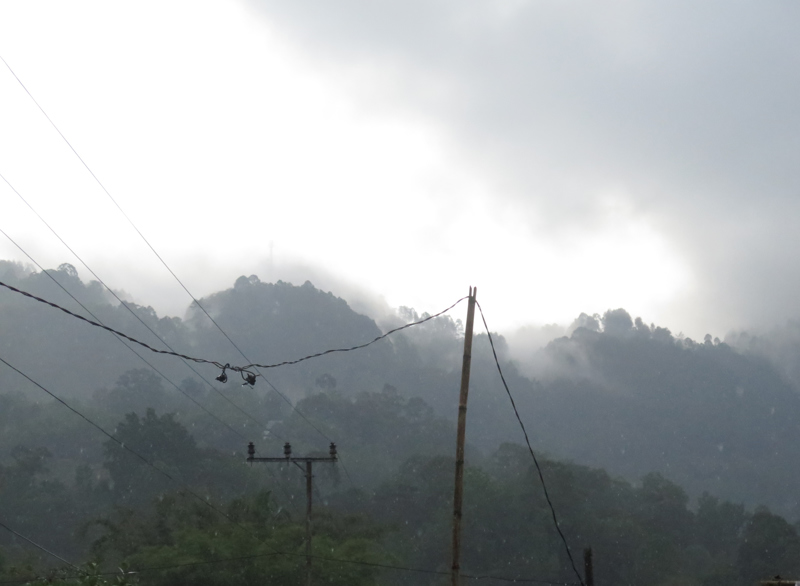



1.
Arrival in Jakarta, Pangandaran, Jogjakarta, Malang
2.
Volcanoes - Mt Semeru, Mt Bromo, Mt Ijen
3.
Ubud - a brief Sojourn
4.
Gilli Trawangan - white beaches and turquoise waters
5.
Boat Cruise - past the Komodo Dragons
6.
Flores - traditional villages and Mt Kelimutu
7.
Kuta, Lombok
8.
Baliem Valley - trekking in the mountains and meeting the Dani tribes
9.
Sentani - the festival and the lake
10.
Tana Toraja - Funerals and Burial Sites
11.
Kuala Lumpur - back in civilisation
12.
Cameron Highlands - trekking and tea plantations
13.
Georgetown, Penang - street art and crumbling mansions
14.
Banda Aceh and Pulau Weh - contending with Ramadan; Scuba Diving and snorkelling in paradise
15.
Lake Toba - the Batak people
16.
Bukit Lawang - Orangutans
17.
Unawatuna
18.
Volunteer Sri Lanka - Week 1
19.
Volunteer Sri Lanka Week 2
20.
Kandy and the East Coast
21.
Ella and Colombo
22.
Volunteer Sri Lanka - final week
23.
Earthbound Expedition - Kathmandu, Poon Hill and Chitwan National Park
24.
Back in Kathmandu
25.
Langtang - solo trekking
26.
Kathmandu to Varanasi